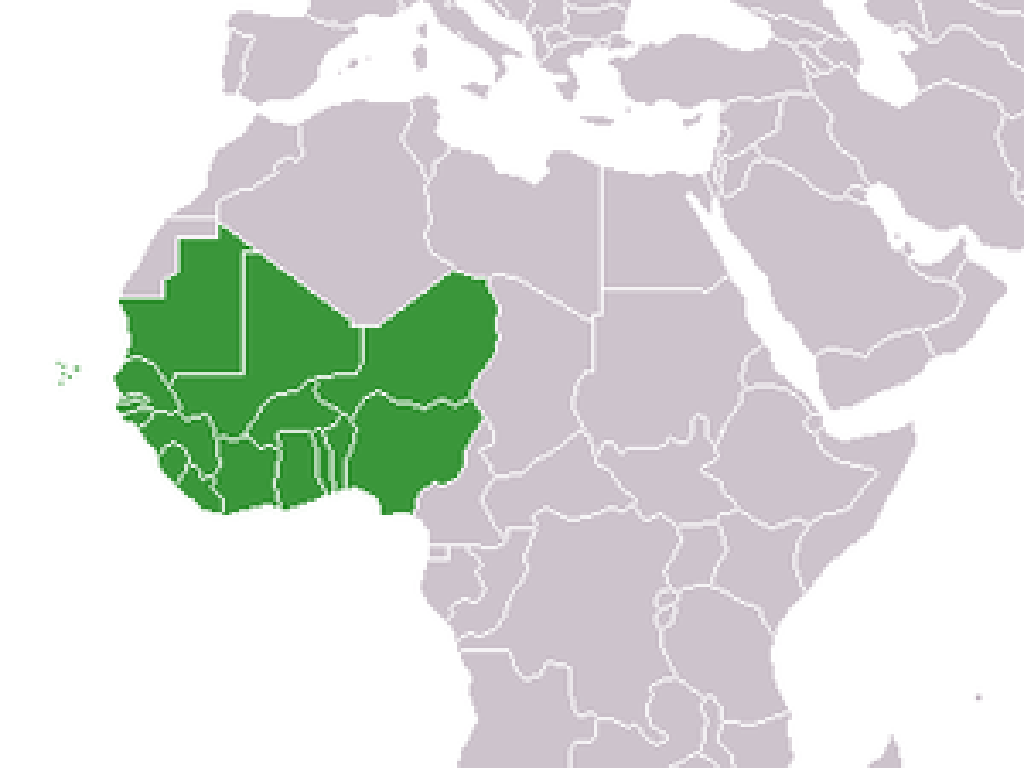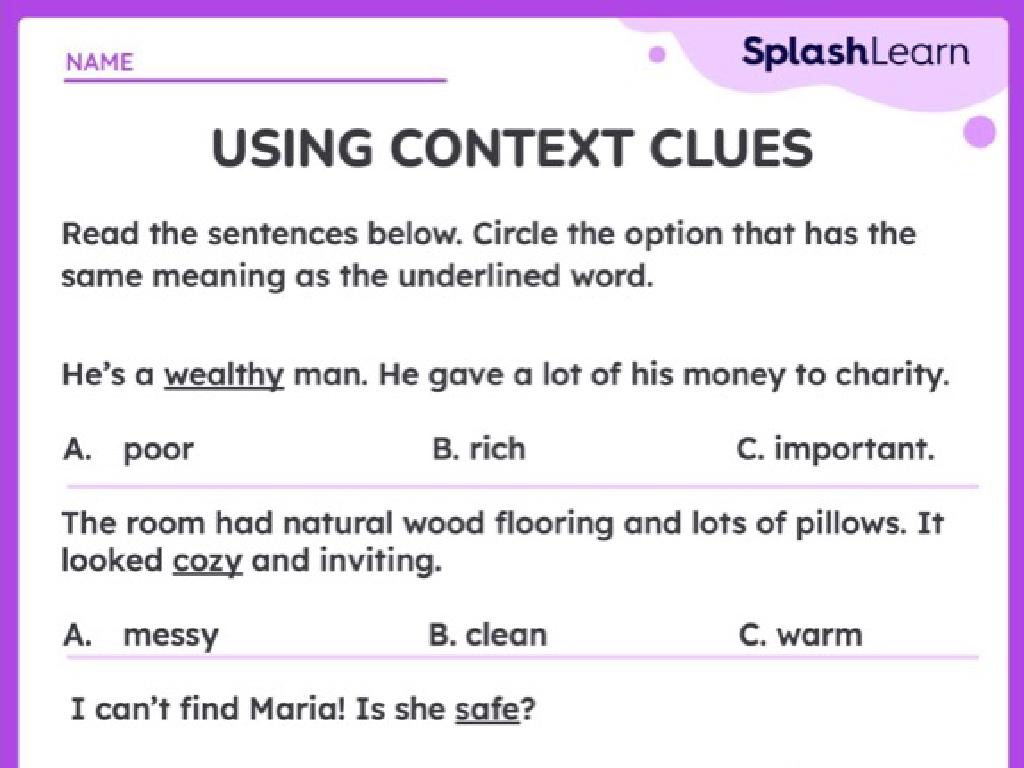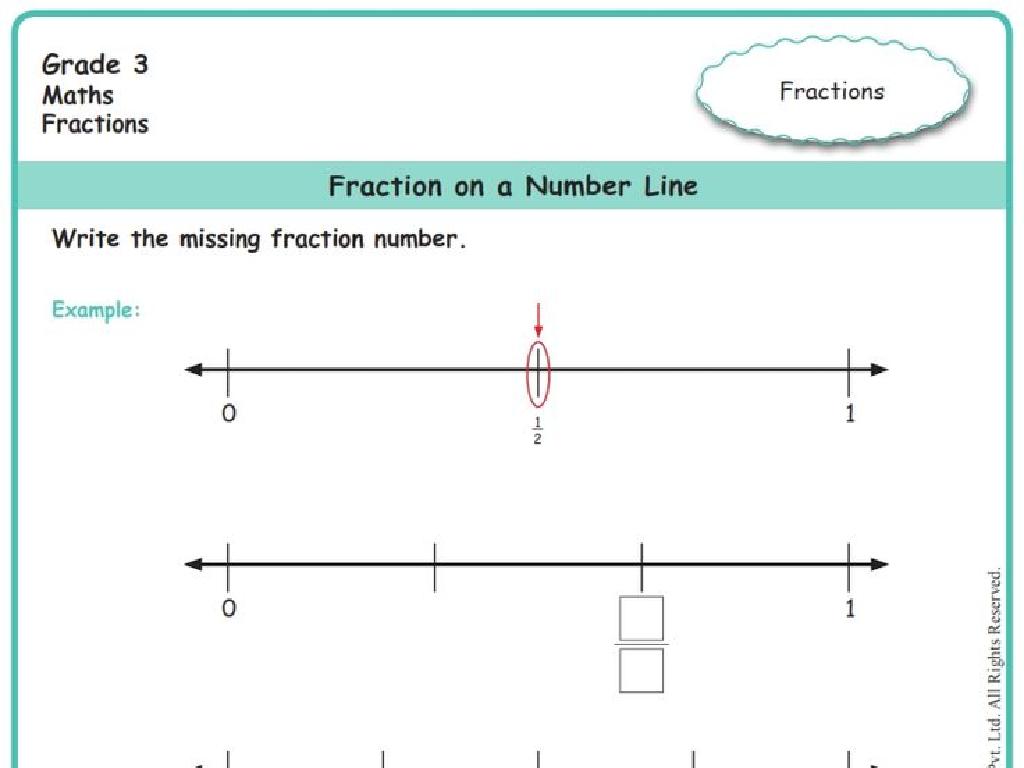Identify The Adjective That Describes The Noun
Subject: Language arts
Grade: Third grade
Topic: Adjectives And Adverbs
Please LOG IN to download the presentation. Access is available to registered users only.
View More Content
Welcome to Adjectives!
– What are adjectives?
– Words that describe or give more information about nouns
– Adjectives describe nouns
– Like ‘tall’ in ‘tall tree’ or ‘blue’ in ‘blue sky’
– They add details to sentences
– ‘The fluffy cat’ or ‘an old, spooky house’
– Examples in everyday language
– ‘A red apple’, ‘five cookies’, ‘a loud noise’
|
This slide introduces the concept of adjectives to third-grade students. Begin by explaining that adjectives are words that give us more information about nouns, which are people, places, or things. Emphasize that adjectives can tell us what something looks like, feels like, sounds like, and more. Provide examples that are relatable to the students, such as describing common items in the classroom or their favorite things. Encourage the students to think of adjectives as ‘describing words’ and ask them to come up with their own examples. This will help them understand how adjectives make sentences more interesting and informative.
Spot the Adjective
– Adjectives describe nouns
– Adjectives give more information about nouns
– They tell us what kind, which one, how many
– ‘large’ elephant, ‘first’ place, ‘three’ apples
– Examples: ‘blue’ sky, ‘seven’ cookies
– ‘Blue’ describes the sky, ‘seven’ tells how many cookies
– Practice finding adjectives in sentences
– We’ll look at sentences and find the describing words together
|
This slide introduces the concept of adjectives to third-grade students. Begin by explaining that adjectives are words that describe nouns, giving more details about things like color, size, quantity, or order. Use clear and relatable examples to illustrate the point. For instance, ‘blue’ tells us the color of the sky, ‘seven’ indicates the number of cookies, and ‘happy’ describes the mood of the dog. Encourage students to think of their own examples. Then, move on to a collaborative activity where students identify adjectives in sample sentences provided by the teacher. This interactive approach will help solidify their understanding of adjectives and how they function within a sentence.
Adjectives in Action
– Adjectives describe nouns
– Can be before the noun
– ‘The quick brown fox’
– Can be after the noun
– ‘The fox that is quick’
– Examples: ‘silly’ clown
– Before: ‘The silly clown’, After: ‘The clown who is silly’
|
This slide introduces the concept of adjectives and their placement in relation to nouns. Adjectives are words that describe or modify nouns, giving us more information about the object, person, or situation. They can be placed directly before the noun to describe it, or they can follow the noun when part of a phrase or clause. Provide examples of both placements using simple, relatable terms. Encourage students to come up with their own sentences, placing adjectives before and after nouns to reinforce the concept. Use illustrations or props like a toy clown to visually demonstrate the adjective’s role in describing the noun.
Comparing with Adjectives
– Adjectives compare things
– Some adjectives show who is ‘more’ or ‘most’
– Examples: ‘taller’, ‘shortest’
– ‘Taller’ compares two, ‘shortest’ compares many
– Describe differences or similarities
– ‘Big’ becomes ‘bigger’, ‘biggest’ for comparing
– Use ‘more’ for two-syllable words
– ‘Happy’ becomes ‘happier’, ‘happiest’; ‘more interesting’, ‘most interesting’
|
This slide introduces the concept of comparative and superlative adjectives to describe and compare things. Emphasize that adjectives can change form to show comparison (‘tall’, ‘taller’, ‘tallest’). Use examples that are relatable to third graders, such as comparing heights or the size of objects. Explain that for words with two or more syllables, we often use ‘more’ or ‘most’ to compare (e.g., ‘more interesting’, ‘most interesting’). During the lesson, engage students with activities where they can practice using these adjectives in sentences to compare their favorite animals, toys, or books.
Your Turn: Spot the Adjectives!
– Find adjectives in sentences
– ‘Green’ and ‘cool’ describe things
– ‘Green’ tells us the color of the frog, ‘cool’ tells us the temperature of the pond
– ‘Big’ and ‘fluffy’ show size and feel
– ‘Big’ tells us about the size of the cat, ‘fluffy’ tells us about the texture
– Share your adjectives with the class
|
This slide is an interactive activity for students to practice identifying adjectives in sentences. Adjectives are words that describe nouns, giving us more information about an object’s size, color, shape, or other qualities. In the provided sentences, students should recognize ‘green’ and ‘cool’ as adjectives describing the frog and the pond, respectively. Similarly, ‘big’ and ‘fluffy’ are adjectives that describe the cat. Encourage students to explain why they think each word is an adjective and what aspect of the noun it describes. After identifying the adjectives, students should be ready to share their answers with the class, fostering a collaborative learning environment.
Class Activity: Adjective Hunt
– Read a story as a class
– Hunt for adjectives in the text
– Adjectives describe nouns, like ‘blue sky’ or ‘loud music’
– Mark each adjective you find
– Discuss the adjectives discovered
– Share why you think each word is an adjective
|
This interactive class activity is designed to help students identify adjectives within the context of a story. Begin by reading a short story aloud to the class, or have students take turns reading. Explain that their task is to listen carefully and spot words that describe nouns these are the adjectives. Provide examples of adjectives before starting. As they identify adjectives, have them mark them with a highlighter or write them down. After the reading, facilitate a discussion where students share the adjectives they found and explain their reasoning. This will reinforce their understanding of adjectives and how they are used in sentences. Prepare a list of potential adjectives that may appear in the story to ensure a productive discussion post-activity.
Wrapping Up: Adjectives
– Recap on adjectives
– Adjectives describe nouns, like ‘fluffy’ cat or ‘red’ apple.
– Importance of adjectives
– They make sentences exciting and give us more information.
– Adjectives for favorites
– Think of a tasty food, a cute animal, or a fun place!
– Class activity
– Share your adjectives with the class!
|
In this concluding slide, we review the key points of the lesson on adjectives. Start by recapping that adjectives are words that describe nouns, giving more detail to the sentences. Emphasize why adjectives are crucial they spice up our language and provide specific details, making our communication clearer and more interesting. Engage the students by asking them to think of adjectives for their favorite food, animal, or place, and encourage them to share with the class. This activity will help solidify their understanding of adjectives and how they can be used in everyday language. It’s also a great opportunity for a fun and interactive class discussion.
Adjective Hunt Results
– Share adjectives from the story
– Discuss the role of adjectives
– Adjectives describe nouns and make stories more interesting.
– Understanding adjective importance
– They add detail and help us picture the story.
– Celebrate our adjective findings!
|
This slide is to recap the activity where students searched for adjectives in a story. Start by having students share the adjectives they found. Facilitate a discussion on how these adjectives enhance the story, focusing on their role in building imagery and adding depth to the narrative. Highlight the importance of adjectives in providing more information about the nouns they describe. Praise the students for their efforts in identifying adjectives, reinforcing their understanding and boosting their confidence. For the activity, consider breaking students into groups and having each group share their findings, or select a few students to share with the class. Encourage them to explain why they think the adjectives are important and how they change the meaning of the nouns they describe.





